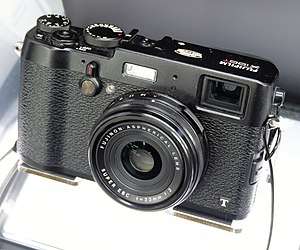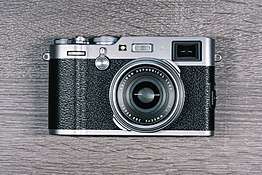Fujifilm X100
The Fujifilm X100 is a series of digital compact cameras with a fixed prime lens. The series includes the FinePix X100, X100S, X100T, X100F, and X100V. They each have a large image sensor and a 23 mm lens (35 mm equivalent angle of view in full frame format). All five cameras have received generally positive reviews.
Fujifilm FinePix X100
 | |
| Overview | |
|---|---|
| Maker | Fujifilm |
| Type | Fixed lens digital camera |
| Lens | |
| Lens | 23 mm (35 mm equivalent[n 1]), f/2 |
| Sensor/medium | |
| Image sensor type | CMOS with primary colour filter (Bayer filter) |
| Image sensor size | 23.6 mm × 15.8 mm (APS-C) |
| Maximum resolution | 12.3 megapixels |
| Recording medium | SD, SDHC, SDXC |
| Focusing | |
| Focus | contrast detection |
| Exposure/metering | |
| Exposure | TTL 256-zones metering |
| Flash | |
| Flash | Built in |
| Viewfinder | |
| Viewfinder | Hybrid (OVF and EVF) |
| General | |
| Rear LCD monitor | 2.8-inch 460k dots fixed LCD |
| Battery | NP-95 type |
| Dimensions | 126.5 (W) × 74.4 (H) × 53.9 (D) mm |
| Weight | 445 g (0.981 lb) (including battery and memory card) |
| Made in | |
The Fujifilm FinePix X100 was initially shown at the photokina show in September 2010 and was subsequently introduced in February 2011.[1] It was the first model in the Fujifilm X-series of cameras and has since been joined by numerous models. It is superseded by the Fujifilm X100S.[2]
Key features
Innovation
The FinePix X100 was the first camera to show a number of new technologies developed by Fujifilm. These include a hybrid viewfinder which allows the user to choose between a conventional optical viewfinder with an electronic overlay, or an electronic viewfinder.[3] The combination of APS-C sized CMOS sensor, EXR processor and 23mm (35 mm equivalent) fast aperture lens was also a first.[4]
Reception
The X100 received generally favourable reviews and a number of awards. These include Innovative Camera of the Year from Ephotozine[5] and Best Premium Camera in the 2011 TIPA awards.[6] In most cases, the prizes were awarded for the combination of technology and picture quality, but the X100 has also received plaudits for its design outside the photography market, coming top of Stuff magazine's Cool List for 2011[7] and in October 2012 receiving Good Design Award from Good Design Award (Japan).[8] Digital Photography Review gave it a score of 75% and a silver award, noting that it "combines excellent image quality, solid build and a superb viewfinder with somewhat sluggish and quirky operation", adding that "It's been much improved by multiple firmware updates since its initial incarnation, and despite its flaws, is now a very likeable camera indeed.".[9]
Issues
Some X100 cameras have reportedly suffered from 'sticky aperture disease' where the aperture blades lock up, leading to overexposure.[10][11] Fujifilm has acknowledged this issue and will fix it under warranty.
On initial release the X100 was widely reported to have various issues.[12] Many, but not all, of these issues were fixed[13] through a series of firmware updates[14] made available by Fujifilm.
Fujifilm X100S
 | |
| Overview | |
|---|---|
| Maker | Fujifilm |
| Type | Fixed lens digital camera |
| Lens | |
| Lens | 23 mm (35 mm equivalent[n 3]), f/2 |
| Sensor/medium | |
| Sensor | CMOS |
| Image sensor type | Fujifilm X-Trans CMOS II |
| Image sensor size | 23.6 mm × 15.8 mm (APS-C) |
| Maximum resolution | 16.3 megapixels |
| Recording medium | SD, SDHC, SDXC |
| Focusing | |
| Focus | contrast detection / phase detection |
| Viewfinder | |
| Viewfinder | Hybrid (OVF and EVF) |
| General | |
| Dimensions | 126.5 (W) × 74.4 (H) × 53.9 (D) mm |
| Weight | 445 g (0.981 lb) (including battery and memory card) |
| Made in | |
The Fujifilm X100S[15] is the successor to the Fujifilm FinePix X100. Announced in January 2013,[2] it is a model similar to the X100 yet addressing some of the issues that the X100 had, and resembles it superficially, but with internal changes. It has been compared with the Leica M series.[16]
It was replaced in September 2014 with the Fujifilm X100T.
Differences from the X100
- 16.3 MP Fujifilm X-Trans CMOS II sensor instead of 12.3 MP CMOS sensor with primary colour filter (Bayer filter)
- Redesign of menus
- Quick Menu (Q) button
- Uses X-Trans color filter pattern (taken from the X-E1 and X-Pro1), instead of Bayer pattern
- No optical low pass filter (OLPF), to give sharper images[18]
- Phase detection within the X-Trans CMOS II sensor increasing autofocus speed to 0.08 s in good light
- The faster the focus ring is rotated, the quicker the focus is adjusted
- Focus mode switch options have been reorganised such that the most commonly used functions (Autofocus Single and Manual Focus) surround the least used function (Autofocus Continuous) for more efficient operation
- Hybrid viewfinder switch has been altered in shape to allow for easier one-handed operation
- Autofocus point selection has been altered to allow one button default access[19]
Reception
The X100S received generally positive reviews:
Fujifilm X100T
 Fujifilm X100T | |
| Overview | |
|---|---|
| Maker | Fujifilm |
| Lens | |
| Lens | 23 mm (35 mm equivalent[n 4]) |
| F-numbers | f/2.0 at the widest |
| Sensor/medium | |
| Sensor | CMOS |
| Image sensor type | Fujifilm X-Trans CMOS II |
| Image sensor size | 23.6 x 15.8 mm (APS-C type) |
| Maximum resolution | 4896 x 3264 (16 megapixels) |
| ASA/ISO range | 100–51200 |
| Recording medium | SD, SDHC or SDXC memory card |
| Focusing | |
| Focus areas | 49 focus points |
| Shutter | |
| Shutter speeds | 1/32000 s to 30 s |
| Continuous shooting | 6 frames per second |
| Viewfinder | |
| Viewfinder magnification | 0.5 |
| Frame coverage | 92% |
| Image processing | |
| Image processor | EXR Processor II |
| Custom WB | Yes |
| General | |
| Rear LCD monitor | 3 inches with 1,040,000 dots |
| Dimensions | 127 x 74 x 52 mm (5 x 2.91 x 2.05 inches) |
| Weight | 440 g including battery |
| Made in | |
The Fujifilm X100T was announced by Fujifilm on September 10, 2014. It is the successor to the X100S.[22] It is visually very similar to the X100S, and shares many of its core specifications (including its lens and sensor), but features numerous iterative refinements and enhancements.[23] It has the same 16.3 MP Fujifilm X-Trans CMOS II sensor as the X100S.[24]
It was replaced in January 2017 with the Fujifilm X100F.
Differences from the X100S
- Advanced hybrid viewfinder, with electronic rangefinder
- Real-time parallax correction in optical viewfinder
- ±3EV exposure compensation
- optional electronic shutter (allowing silent operation and a shutter speed of 1/32000 of a second)
- 3.0-inch, 1040K-dot LCD screen
- "Classic Chrome" film simulation mode
- Built-in Wi-Fi
- Face recognition (when enabled, focuses automatically on the faces in the frame)
Reception
The X100T has received generally positive reviews:
- Digital Photography Review gave it a score of 81%, criticising its autofocus and video capabilities but noting "there's currently nothing to touch it in terms of the size/price/image quality balance it offers and the style with which it does so".[23]
- Pocket-Lint.com gave it 4 stars out of 5, describing it as "a special little camera"[25]
Fujifilm X100F
The Fujifilm X100F (Fourth), announced on January 19, 2017[26] is the successor to the Fujifilm X100T. It features a number of improvements and refinements over the previous model, many of which were first introduced with the Fujifilm X-Pro2. The X100F was released on February 23, 2017.[27]

Differences from the X100T
- A third-generation 24.3 MP X-Trans CMOS III sensor
- X-Processor Pro image processor
- A new button layout with a joystick autofocus control (similar to X-Pro2 and X-T2), making it easier to select AF points[29]
- Built-In ISO dial
- Added command dial on the front of the camera
- C mode on exposure compensation dial, allowing up to 5 stops exposure compensation
- A larger battery, model NP-W126S (same as X-T2)
- An improved 91-point autofocus system
- Improved sensitivity (ISO 200–12800, expandable to ISO 100–51200)
- Viewfinder has 6x magnification
- Acros film simulation
- 60 fps EVF refresh rate[30]
- Additional continuous shooting mode speeds (3, 4, 5, and 8 fps) along with larger buffer
- New LED AF lamp
- Digital teleconverter simulating 50 mm and 70 mm perspectives (JPG only)
Reception
The X100F was very well received, mostly for its improved sensor and autofocus capability. Digital Photography Review gave it a score of 83% and a gold award, calling it "a true photographers' camera".[31] At the 2017 Technical Image Press Association Awards, the X100F won the award for best professional compact camera.[32]
Fujifilm X100V
The Fujifilm X100V (Roman Numeral “Fifth”), announced on February 4, 2020 is the successor to the Fujifilm X100F[33]. It features a redesigned lens, the 4th generation of X-Trans sensor, a 2-way tilting rear LCD screen, and an “optional” weather resistance.
Differences from the X100F
- A fourth-generation 26.1MP X-Trans CMOS sensor
- Sharper 23mm f/2.0 lens
- Video recording at 4K/30p or 1080/120p
- 2-way tilting rear LCD screen
- Weather resistance
Accessories
Due to their similarities, the different X100 cameras accept many of the same accessories.
Conversion lenses
- Wide Conversion Lens WCL-X100 II - gives a magnification factor to the 23 mm fixed lens of 0.8×, providing a focal length of 19 mm (28 mm equivalent[n 5])[34]
- Tele Conversion Lens TCL-X100 II - multiplies the 23 mm fixed lens by approximately 1.4×, providing an equivalent focal length of 33 mm (50 mm equivalent angle of view)[35]
Flashguns
- Fujifilm EF-20
- Fujifilm EF-X20
- Fujifilm EF-42
See also
- Fujifilm X series
- Fujifilm cameras
Notes
References
- "Fujifilm announces commercial release of FinePix X100: Digital Photography Review". Digital Photography Review. 2011-02-08. Retrieved 2016-02-26.
- Westlake, Andy (January 2013). "Fujifilm X100S First Look". Digital Photography Review. Retrieved 11 March 2013.
- "FinePix X100 Pro / Enthusiast Camera Features (page 3)". Fujifilm United Kingdom. Archived from the original on October 9, 2011. Retrieved April 13, 2012.
- "FinePix X100 Pro / Enthusiast Camera Features (page 1)". Fujifilm United Kingdom. Archived from the original on October 9, 2011. Retrieved April 13, 2012.
- "ePHOTOzine's Best Cameras Of The Year 2011". Ephotozine.com. Retrieved 2016-02-26.
- "XXI TIPA AWARDS 2011". Technical Image Press Association. Archived from the original on April 24, 2011. Retrieved April 13, 2012.
- "Stuff Cool List 2011". Stuff. Archived from the original on August 7, 2011. Retrieved April 13, 2012.
- "デジタルカメラ [FUJIFILM X100 BLACK] | 受賞対象一覧 | Good Design Award". G-mark.org (in Japanese). Retrieved 2016-02-26.
- Westlake, Andy. "Fujifilm FinePix X100 In-Depth Review". Digital Photography Review. Retrieved 25 March 2015.
- "'Sticky Aperture Blade' issue | Fuji X Forum". X100forum.com. Archived from the original on 2013-02-09. Retrieved 2016-02-26.
- Eastland, Jonathan (2011). "Modern retro". British Journal of Photography. Incisive Financial Publishing Limited. 158 (7788): 68–71.
The sad fact is, at least in my opinion, that apart from its sumptuous image quality, operationally the X100 only does what it says on the tin in AF mode for subjects normally requiring a measured approach. ... Unfortunately, for relatively fast-moving subjects, or where the camera is used to grab candid frames in a hurry, the system returns a fairly hit-and-miss sharply focused average.
- Britton, Barney (10 January 2013). "Hands-on with Fujifilm's X100S". Digital Photography Review. Retrieved 17 March 2013.
- "Firmware for FinePix X100". Fujifilm. Retrieved 17 March 2013.
- "Fujifilm X100S - Specifications | X Series | Digital Cameras". Fujifilm USA. Retrieved 2013-09-09.
- "Strobist: In-Depth: The New Fujifilm X100s". Strobist.blogspot.com. 2013-03-22. Retrieved 2013-09-09.
- "A comparison between the X100T and X100S". www.fujivsfuji.com. Fuji vs Fuji. Retrieved 25 March 2015.
- "FUJIFILM X100S - Feature: APS-C 16M X-Trans CMOS II Sensor & EXR Processor II | X Series | Digital Cameras". Fujifilm USA. Retrieved 2013-09-09.
- "Fuji x100s Review :: A Camera Walks Into A Bar • Photography By Zack Arias • ATL • 404-939-2263 • studio@zackarias.com". Zackarias.com. 2013-03-22. Retrieved 2016-02-26.
- Britton, Barney; Westlake, Andy. "Fujifilm X100S Review". Digital Photography Review. Retrieved 25 March 2015.
- Mansurov, Nasim. "Fuji X100S Review". www.photographylife.com. Photography Life. Retrieved 25 March 2015.
- "Fujifilm X100T: Digital Photography Review". Digital Photography Review. 2014-09-10. Retrieved 2016-02-26.
- Butler, Richard. "Fujifilm X100T Review". Digital Photography Review. Retrieved 25 March 2015.
- "Fujifilm X100T Review". DPReview. Retrieved 2018-07-02.
- Lowe, Mike. "Fujifilm X100T review: Naughty but niche". www.pocket-lint.com. Pocket Lint. Retrieved 25 March 2015.
- "Premium Compact Digital Camera "FUJIFILM X100F" — X Series' most powerful new addition featuring the latest 24.3 megapixel sensor and processor". Fujifilm Global. Retrieved 2017-01-19.
- "Fujifilm X100F, X-T20, X-T2 Graphite & XF50mm Final Release Date - PRESS RELEASE - Fuji Rumors". Fuji Rumors. 2017-01-31. Retrieved 2017-01-31.
- "Fujifilm X100F". Fujifilm Global. Retrieved 2017-01-19.
- Seifert, Dan. "Hands on with Fujifilm's new X100F and X-T20". The Verge. Retrieved 2017-01-19.
- "Fujifilm X100F - Feature 4 Performance". Fujifilm Global. Retrieved 2017-01-19.
- "Fujifilm X100F". Digital Photography Review.
- "TIPA - TECHNICAL IMAGE PRESS ASSOCIATION - This year's awards". www.tipa.com (in Italian). Retrieved 2017-10-24.
- "Fujifilm Unveils X100V with New Lens, 'Optional' Weather Sealing, and More". PetaPixel. February 4, 2020.
- "Archived copy". Archived from the original on 2012-07-15. Retrieved 2016-08-27.CS1 maint: archived copy as title (link)
- http://www.fujifilm.com/news/n140416_02.html
External links
- Official website of the original Finepix X100 (Wayback Machine Archive)
- Official Fujifilm Global website of the original Finepix X100
- Official Fujifilm Global website of the X100S
- Official Fujifilm Global website of the X100T
- Official Fujifilm Global website of the X100F
